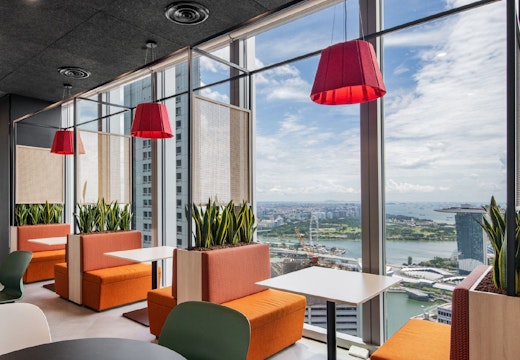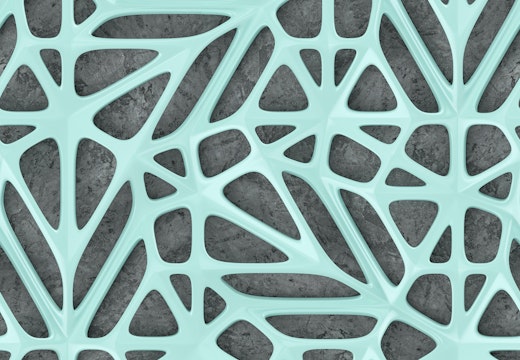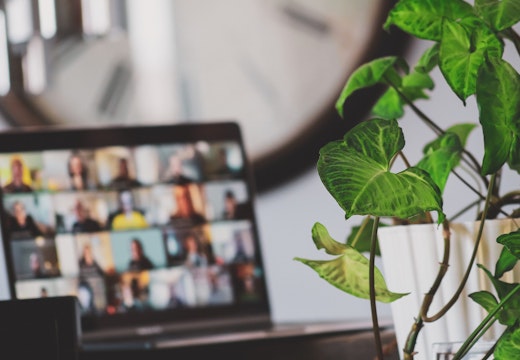Designing for diversity: healthy culture, healthy employees
Designing for a more diverse workforce must go deeper than providing ramps for wheelchairs. In the latest in our series on health and work with Adrianse, we explore the wellbeing benefits of being welcomed and respected
Health and happiness are deeply linked to inclusion. Feeling welcome in your environment is a core part of employee wellbeing.
Research by neuroscientist Matthew Lieberman suggests that we are always evaluating our environment and looking for signs of social rejection. If we find these signs, they are registered in the same part of the brain that registers physical pain. This indicates that feeling left out or isolated at work can have a significant impact on employee wellbeing and happiness.
How the built environment is designed and who it is designed for can have a significant impact on these feelings of inclusion and exclusion. Ground-breaking research by Becker and Stele suggests that the messages we receive from the physical environment around us communicate more about a company’s values than the corporate messaging that firms put out (1995).
This means that if our working environment doesn’t support our physical, emotional and professional needs then we will understand this lack of support as typifying the values of the company we work for. So, how can organisations have a more inclusive approach to workplace design that boosts employee health and wellbeing?
Think more deeply
This article is the fourth in a series on the multi-faceted relationship between health and work. It is a collaboration between global design firm Adrianse and WORKTECH Academy. Adrianse has strong roots in the Asia Pacific region, notably India and Singapore, and brings a wealth of experience in designing and building workspaces, healthcare environments and data centres.
Read the first introductory article in the series here, the second article on the health challenges of hybrid working here, and the third article on biomorphism, design and health here.
According to Adrianse director Chinmayee Ananth, ‘The drive to design wellness-compliant workspace is now very strong. But while such initiatives are expanding, too many are just transactional and programmatic. We need to think more deeply and conceptually about the inter-connections between health and work. This is especially true when it comes to diversity, equity and inclusion (DEI). Too much activity in this area is still about ticking boxes and not enough about the underlying motivations and behaviours. When asked if they respect diversity, companies will say “we have a ramp for wheelchairs”.’
Ending exclusion
In the past, most offices were designed for the ‘standard’ employee (typically male aged 20 to 40, white, neurotypical, able-bodied), a group described by economists as ‘the family formation workforce’. But in recent years it has been recognised how exclusionary this approach has been, entrenching even further the inequalities already present in the workplace.
For the many employees who sit outside this mould, those who are perhaps neurodiverse, older, female or with different abilities, working in a workplace designed specifically for such a narrow group offers significant challenges. Employees can feel excluded from the culture of the workplace. This has an impact their mental health by highlighting to them that they are not welcome or forcing them to work in conditions or use equipment that they find unnecessarily stressful.
It is also important to recognise that employee needs can also change over time and that our health is not static. Employees that join the company with no previous experiences of ill health or disability may experience a change in circumstances over the course of their employment. In these instances, when an employee’s experience of their health changes, their workplace should change to accommodate their needs – or they will also feel excluded, compounding their experiences of ill health.
A new approach
To ensure that all employees feel included and part of the culture of a workplace, a new approach is needed. Instead of approaching office design from a one-size-fits-all perspective, designing for the extremes of need – for the margins not just the mainstream – can ensure that everyone who steps into the building feels like they are an equal. This approach ensures that the health and wellbeing of all is protected and not negatively affected by the built environment around them.
At Adrianse, this approach to workplace design has three core tenets: designing from multiple perspectives; designing for choice and flexibility; and designing with cultural sensitivity.
Multi-vocal design
It is only when we stop to ask whose voices are not being heard in the design process that we can begin to address the fundamental biases that are built into workplaces. Taking an array of voices into account and incorporating a variety of different perspectives into the design process, can help challenge perceived norms, highlight inequalities, and create new solutions to the problem of exclusion within the workplace.
Instead of designing with a hierarchical approach in mind, levelling the playing field and taking the voices of underrepresented groups seriously can transform the design of the workplaces. At Adrianse, this is an approach that the company not only practices with its clients but embodies within its own organisation.
Through a year-long program called Adriance Advance, Adrianse has deepened its commitment to including a wider array of voices. This program brings together everyone from within the organisation, from architects to marketers, and requires them to spend time listening and collaborating with each other on a series of projects.
For under-represented groups, being foregrounded and being able to comfortably state your needs in an open environment can make all the difference to creating a sense of inclusion. And research also suggests that diverse teams outperform more homogenous teams, suggesting that if workplace are more inclusive and welcome a wider range of people into their workplace they will be rewarded with healthier employees and a healthier performance in the global marketplace.
Freedom to choose
Not everyone has the same needs when it comes to workspace and the ability to choose from a variety of environments can ensure that everyone can access space where they are productive and feel comfortable.
Up to a fifth of the world’s population is neurodiverse, which means people have a condition such as dyslexia, autism or ADHD. However, not all neurodiverse people have the same needs: some may be overwhelmed by a large amount of sensory stimulation and require spaces where they can find quiet and calm, whilst others might normally be under-stimulated and require spaces which are bright, engaging and offer more sensory stimulation in order to work at their best. Working in conditions that are overwhelming or underwhelming can have a significant negative impact on the health of neurodiverse workers and cause high levels of stress.
‘Designing for personal agency and choice means you can create a space of wellbeing for all…’
Meeting these differing needs appears challenging, but as Adrianse Director Jayanth Gopal states, ‘By designing for personal agency and choice you can bring into focus a space of wellbeing for all. That is what it means to design for neurodiversity.’ By building in choice and flexibility, designers are providing workers with different environments from which they can select the best environment for themselves as an individual.
This approach is typified by Adrianse’s design of the Expedia office in Gurugram and Bengaluru, India. The design lead on the project, Chinmayee Ananth, states that the primary principle of the space was to ‘let people be themselves and offer them a range of choices for where to work’. By acknowledging that employees know themselves best, and by empowering them to make their own decisions through the provision of a mix of social spaces and quieter, reflective spaces, this office ensures that the widest range of needs of Expedia’s employees are met.
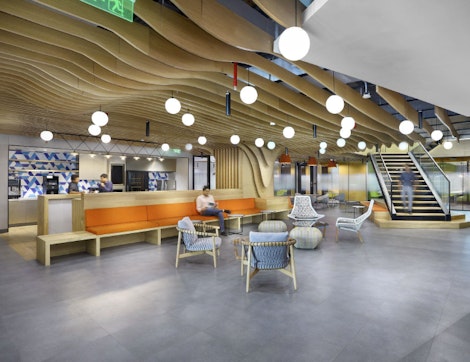
Image: Expedia, courtesy of Adrianse
Cultural inclusivity
Culture is an often-overlooked element of inclusive design, with a tendency to believe that in our increasingly globalised world the differences between cultures within the workplace are decreasing. However, there is a significant amount of research that proves that this is not the case. Understanding the local culture of a specific area is an important element in creating an inclusive space where people feel comfortable.
The Amercian social psychologist Richard Nisbet states that ‘people think about—and even see—the world differently because of differing ecologies, social structures, philosophies, and educational systems’ (2003). The cultures that we live in shape our experiences of the environment around us and must therefore be taken into account when spaces are being designed for our needs.
As research by Norwegian academic Tor Grenness (2015) shows, what works for one culture will not work for another. In reference to a Norwegian firm called Telenor that opened offices in Asia, Grenness stated that ‘it was fairly obvious that Telenor had not given the issue [of alignment with national culture] much thought. Its overall strategy was to copy the design of its head office in Norway . . . and begin its operations in various Asian countries without much further consideration’. What worked for Norwegians didn’t work for the company’s Asian offices and overlooking cultural differences can lead to a failure to provide appropriate office space for all employees.
In contrast, by considering the needs of local people on a deep level, workplaces can create a sense of inclusion and familiarity which can promote wellbeing within the organisation. Adrianse’s design for Pfizer’s Chennai office typifies this in-depth awareness to cultural needs. Whilst acknowledging Pfizer as a global brand, Adrianse also recognised the cultural history of Chennai within its design and wanted to open the door for employees to take part in the Pfizer’s global culture without the space being intimidating or unfamiliar.
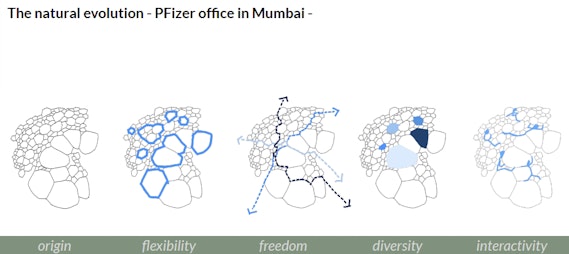
Image: courtesy of Adrianse
To do this, they took inspiration from the rich culture and history of the city, drawing inspiration from Tamil literature and Sangam stories to create recognisable graphics and features which are visible throughout the space. Creating spaces which take into account the cultural preferences and expectations of the local community and designing the space to reflect shared values offers a focal point around which employees can identify. This can help employees feel included in the culture of a company, even within a giant global brand.
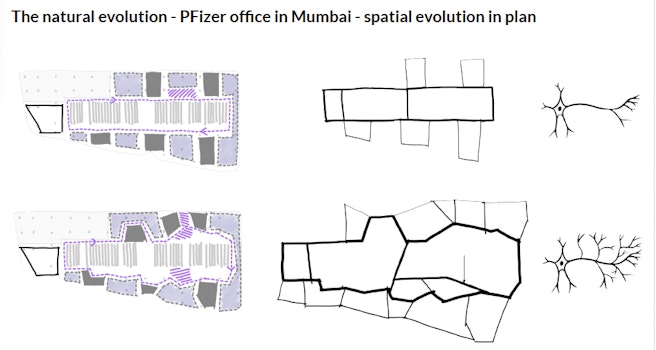
Image: courtesy of Adrianse
Inclusive space is healthy space
Healthy workspaces are ones in which everyone feels welcome and comfortable. Designing for inclusion ensures that we leave the one-size-fits-all approach behind and instead create workplaces which reflect the diversity of experiences within a company. By inviting a wider range of voices to the table, by offering a high degree of choice and flexibility, and by taking into account cultural sensitivities, workplace designers can create happier, healthier and more diverse offices.
This article series has considered the technical, natural and cultural systems that underpin a healthier workplace. In the final article, we conclude the series by considering the spatial systems that bind health and work.
References
Franklin Becker and Fritz Steele. 1995. Workplace by Design: Mapping the High-Performance Workscape. Jossey-Bass: San Francisco, CA.
Richard Nisbett. 2003. The Geography of Thought: How Asians and Westerns Think Differently . . . and Why. Free Press: New York.
Tor Grenness. 2015. ‘Culture Matters: Space and Leadership in a Cross-Cultural Perspective.’ In Arja Ropo, Perttu Salovaara, Erika Sauer, and Donatella De Paoli (eds.). Leadership in Spaces and Places. Edward Elgar Publishing: Northampton, MA, pp. 199-214.


